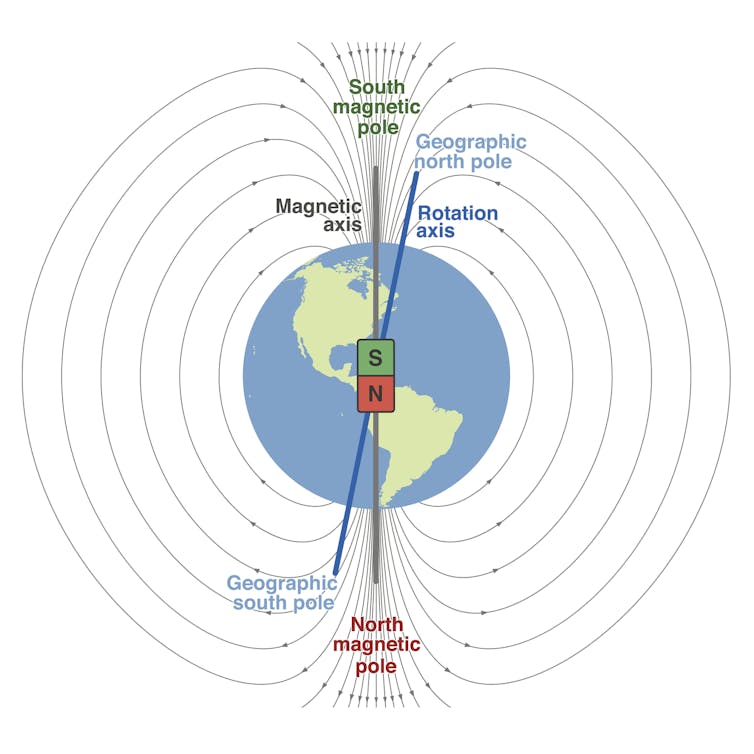Aqua’s Barbie Girl played by electric devices with a toothbrush as Barbie and a shaver as Ken. The percussion is handled by a steam iron and two typewriters. The bass is played by another electric toothbrush and three credit card machines complement the harmonies.
The Only Real God [Comic]
[Source: @martin_rosner]
Happy Krampusnacht! [Comic]
True Facts: The Science of Real-Life Superpowers
The science or real-life superpowers in animals and insects by the always amusing Ze Frank. Enjoy!
[Ze Frank]
Earth’s magnetic field protects life on Earth from radiation, but it can move, and the magnetic poles can even flip

The Earth’s magnetic field plays a big role in protecting people from hazardous radiation and geomagnetic activity that could affect satellite communication and the operation of power grids. And it moves.
Scientists have studied and tracked the motion of the magnetic poles for centuries. The historical movement of these poles indicates a change in the global geometry of the Earth’s magnetic field. It may even indicate the beginning of a field reversal – a “flip” between the north and south magnetic poles.
I’m a physicist who studies the interaction between the planets and space. While the north magnetic pole moving a little bit isn’t a big deal, a reversal could have a big impact on Earth’s climate and our modern technology. But these reversals don’t happen instantaneously. Instead, they occur over thousands of years.

Magnetic field generation
So how are magnetic fields like the one around Earth generated?
Magnetic fields are generated by moving electric charges. A material that enables charges to easily move in it is called a conductor. Metal is one example of a conductor – people use it to transfer electric currents from one place to the other. The electric current itself is simply negative charges called electrons moving through the metal. This current generates a magnetic field.
Layers of conducting material can be found in the Earth’s liquid iron core. Currents of charges move throughout the core, and the liquid iron is also moving and circulating in the core. These movements generate the magnetic field.
Earth isn’t the only planet with a magnetic field – gas giant planets like Jupiter have a conducting metallic hydrogen layer that generates their magnetic fields.
The movement of these conducting layers inside planets results in two types of fields. Larger motions, such as large-scale rotations with the planet, lead to a symmetric magnetic field with a north and a south pole – similar to a toy magnet.
These conducting layers may have some local irregular motions due to local turbulence or smaller flows that do not follow the large-scale pattern. These irregularities will manifest in some small anomalies in the planet’s magnetic field or places where the field deviates from being a perfect dipole field.
These small-scale deviations in the magnetic field can actually lead to changes in the large-scale field over time and potentially even a complete reversal of the polarity of the dipole field, where the north becomes south and vice versa. The designations of “north” and “south” on the magnetic field refer to their opposite polarities – they’re not related to geographic north and south.

The Earth’s magnetosphere, a protective bubble
The Earth’s magnetic field creates a magnetic “bubble” called the magnetosphere above the uppermost part of the atmosphere, the ionosphere layer.
The magnetosphere plays a major role in protecting people. It shields and deflects damaging, high-energy, cosmic-ray radiation, which is created in star explosions and moves constantly through the universe. The magnetosphere also interacts with solar wind, which is a flow of magnetized gas sent out from the Sun.
The magnetosphere and ionosphere’s interaction with magnetized solar wind creates what scientists call space weather. Usually, the solar wind is mild and there’s little to no space weather.
However, there are times when the Sun sheds large magnetized clouds of gas called coronal mass ejections into space. If these coronal mass ejections make it to Earth, their interaction with the magnetosphere can generate geomagnetic storms. Geomagnetic storms can create auroras, which happen when a stream of energized particles hits the atmosphere and lights up.
During space weather events, there’s more hazardous radiation near the Earth. This radiation can potentially harm satellites and astronauts. Space weather can also damage large conducting systems, such as major pipelines and power grids, by overloading currents in these systems.
Space weather events can also disrupt satellite communication and GPS operation, which many people rely on.
Field flips
Scientists map and track the overall shape and orientation of the Earth’s magnetic field using local measurements of the field’s orientation and magnitude and, more recently, models.
The location of the north magnetic pole has moved by about 600 miles (965 kilometers) since the first measurement was taken in 1831. The migration speed has increased from 10 miles per year to 34 miles per year (16 km to 54 km) in more recent years. This acceleration could indicate the beginning of a field reversal, but scientists really can’t tell with less than 200 years of data.
The Earth’s magnetic field reverses on time scales that vary between 100,000 to 1,000,000 years. Scientists can tell how often the magnetic field reverses by looking at volcanic rocks in the ocean.
These rocks capture the orientation and strength of the Earth’s magnetic field when they are created, so dating these rocks provides a good picture of how the Earth’s field has evolved over time.
Field reversals happen fast from a geologic standpoint, though slow from a human perspective. A reversal usually takes a few thousand years, but during this time the magnetosphere’s orientation may shift and expose more of the Earth to cosmic radiation. These events may change the concentration of ozone in the atmosphere.
Scientists can’t tell with confidence when the next field reversal will happen, but we can keep mapping and tracking the movement of Earth’s magnetic north.
Ofer Cohen, Associate Professor of Physics and Applied Physics, UMass Lowell
This article is republished from The Conversation under a Creative Commons license. Read the original article.
Today’s Hottest Deals: Complete Monty Python’s Flying Circus, Soundcore Headphones and Speakers, EGO Star Wars The Razor Crest 75331 UCS Set, and MORE!
For today’s edition of “Deal of the Day,” here are some of the best deals we stumbled on while browsing the web this morning! Please note that Geeks are Sexy might get a small commission from qualifying purchases done through our posts (As an Amazon associate or a member of other affiliate programs. As an Amazon Associate, I earn from qualifying purchases.)
–Up to 46% Off on Soundcore Headphones and Speakers (I have the Q30 Model that’s for sale at home, and for the price, they’re amazing!)
–Monty Python’s Flying Circus: The Complete Series [Blu-ray] – $129.98 $64.99
–LEGO Star Wars The Razor Crest 75331 UCS Set (6,187 Pieces), Ultimate Collectors Series Starship Model Kit for Adults – $599.99 $419.99
–USB C to USB C Cable (240W) [3 Pack: 3.3FT/3.3FT/6.6FT] – $39.99 $9.99
–ASUS ROG Strix NVIDIA GeForce RTX™ 4070 Ti OC Edition Gaming Graphics Card (PCIe 4.0, 12GB GDDR6X, HDMI 2.1a, DisplayPort 1.4a) – $1,049.99 $899.99
–Save on Projectors by Anker Nebula (4K and 1080p)
–Up to 40% Off on Vacuums and Robotic Vacuums by Eufy
–Microsoft Office Professional Plus 2019 for Windows: One-Time Purchase – $229.00 $29.97
–CamelBak Chute Mag 32oz Vacuum Insulated Stainless Steel Water Bottle – $35.00 $16.79
Hyperdrive into Gaming Greatness with the Logitech G502 X PLUS Millenium Falcon Gaming Mouse and Star Wars XL Mouse Pads
In honor of the 40th Anniversary of Star Wars: Episode VI, Logitech introduced three new gorgeous product to the Logitech G line: the G502 X Plus Millennium Falcon gaming mouse, and the G840 XL Battle of Endor and G840 XL Darth Vader mouse pads.
Take up the fight against the Empire once again with the G502 X PLUS portraying the iconic Millennium Falcon with customizable LIGHTSYNC RGB animations. G502 Gaming Mouse is the world’s most popular mouse. G502 X PLUS is reinvented and redesigned with the latest innovations in gaming technology, featuring all-new hybrid optical-mechanical switch technology: LIGHTFORCE. Now, incredible speed and reliability, as well as precise actuation are one. Complete with updated LIGHTSPEED wireless with 68% faster response rate, HERO 25K sub-micron sensor and more.
–Logitech G502 X PLUS Millenium Falcon Edition Gaming Mouse
–Logitech G840 Extra Large Battle of Endor Gaming Mouse Pad
–Logitech G840 Extra Large Darth Vader Gaming Mouse Pad
Please note that Geeks are Sexy might get a small commission from qualifying purchases done through our posts (As an Amazon associate or a member of other affiliate programs. As an Amazon Associate, I earn from qualifying purchases.)
Absolute Chaos [Comic]
[Source: @pizzacakecomic]
Now Try to Skip This [Comic]
[Source: @cheddarbaconstudios]
ROCKSTAR Finally Releases Trailer for Grand Theft Auto VI
Get ready to rev your engines and dive back into the world of crime and chaos, as Rockstar Games has just dropped the bombshell we’ve all been waiting for: the first trailer for Grand Theft Auto VI is finally here!
As part of Rockstar Games’ 25th Anniversary celebrations, the trailer was set to be revealed on a specific date, but fate had other plans. Thanks to an unexpected leak, the highly anticipated sneak peek into the next installment of the open-world crime saga has hit the screens a day earlier than scheduled. Check it out!








